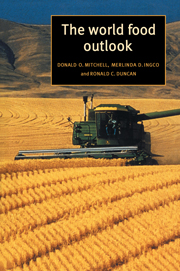Book contents
- Frontmatter
- Contents
- List of figures
- List of tables
- Preface
- List of abbreviations
- 1 The world food problem
- 2 The price of food
- 3 Gains in consumption levels
- 4 World food production increases
- 5 Population growth and food demand
- 6 The quantity and quality of the resource base
- 7 Raising yields
- 8 Changing consumption patterns
- 9 Simulating the future world food situation
- 10 The world can feed twice as many in twenty years
- 11 A robust prediction?
- 12 Africa presents a special challenge at the turn of the century
- Appendix The World Grains Model
- References
- Index
8 - Changing consumption patterns
Published online by Cambridge University Press: 06 November 2009
- Frontmatter
- Contents
- List of figures
- List of tables
- Preface
- List of abbreviations
- 1 The world food problem
- 2 The price of food
- 3 Gains in consumption levels
- 4 World food production increases
- 5 Population growth and food demand
- 6 The quantity and quality of the resource base
- 7 Raising yields
- 8 Changing consumption patterns
- 9 Simulating the future world food situation
- 10 The world can feed twice as many in twenty years
- 11 A robust prediction?
- 12 Africa presents a special challenge at the turn of the century
- Appendix The World Grains Model
- References
- Index
Summary
Growth in food demand is important in assessing the sustainability of the world food system. The role of structural changes in demand due to demographic transitions and increasing incomes in developing economies has usually been omitted in previous assessments of the world food outlook. In fast-developing countries in Asia, direct per capita consumption of traditional foods is declining as people add variety to their diet by eating higher-valued and processed foods. In Africa, millet, sorghum and starchy roots remain the major source of calories, but the per capita intake and their dietary share have declined in most economies while consumption of non-staple cereals (rice and wheat) has steadily increased. In high-income economies, on the other hand, consumers are looking for ‘healthier’ foods and are reducing consumption of red meats and animal fats.
Since 1961, per capita consumption of rice in Japan has declined from about 107 kilograms to less than 65 kilograms, while meat consumption has increased from about 5 to nearly 40 kilograms. While Japan is not typical of Asian economies, since it has achieved the highest income level in Asia (US$26,920 per capita in 1991, World Bank 1991), similar changes in consumption patterns also appear to be under way in other economies such as Malaysia, Nepal, Singapore, Thailand and Taiwan. In China, per capita rice consumption has not increased in nearly a decade while meat consumption has risen rapidly (figure 8.1).
While there have been numerous food demand studies, most have focused on single commodities.
- Type
- Chapter
- Information
- The World Food Outlook , pp. 73 - 105Publisher: Cambridge University PressPrint publication year: 1997



